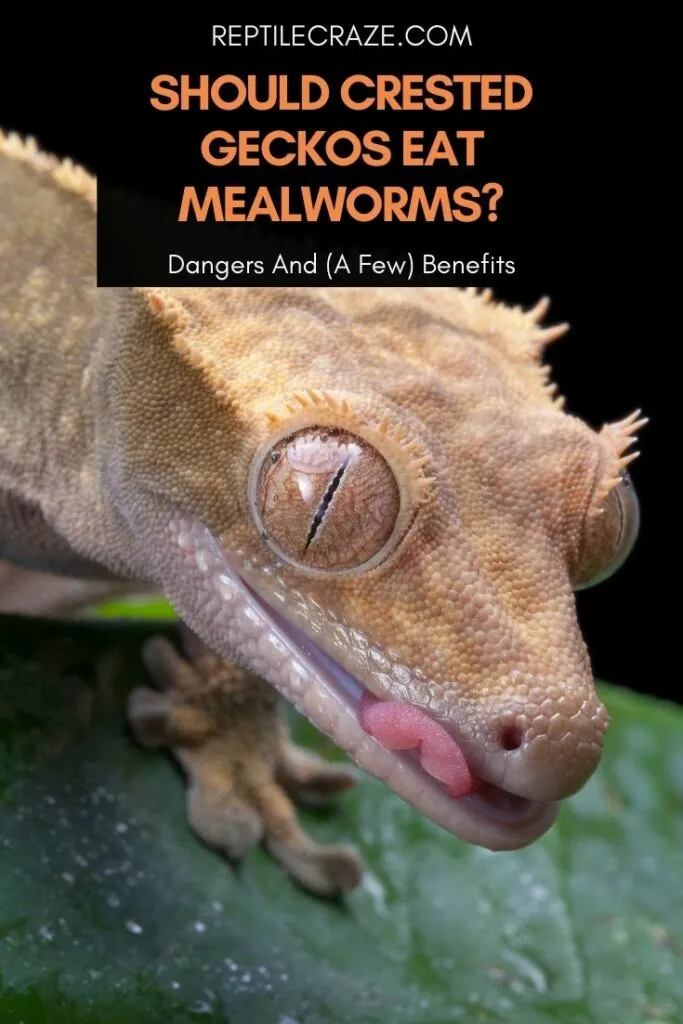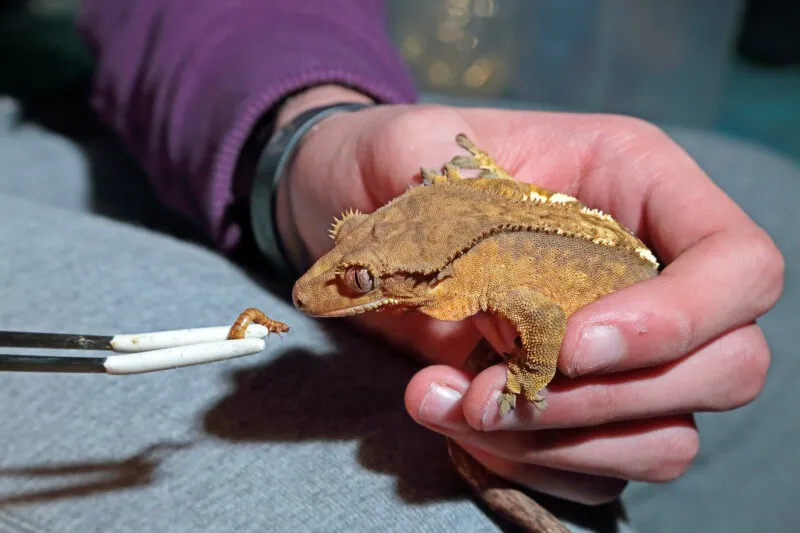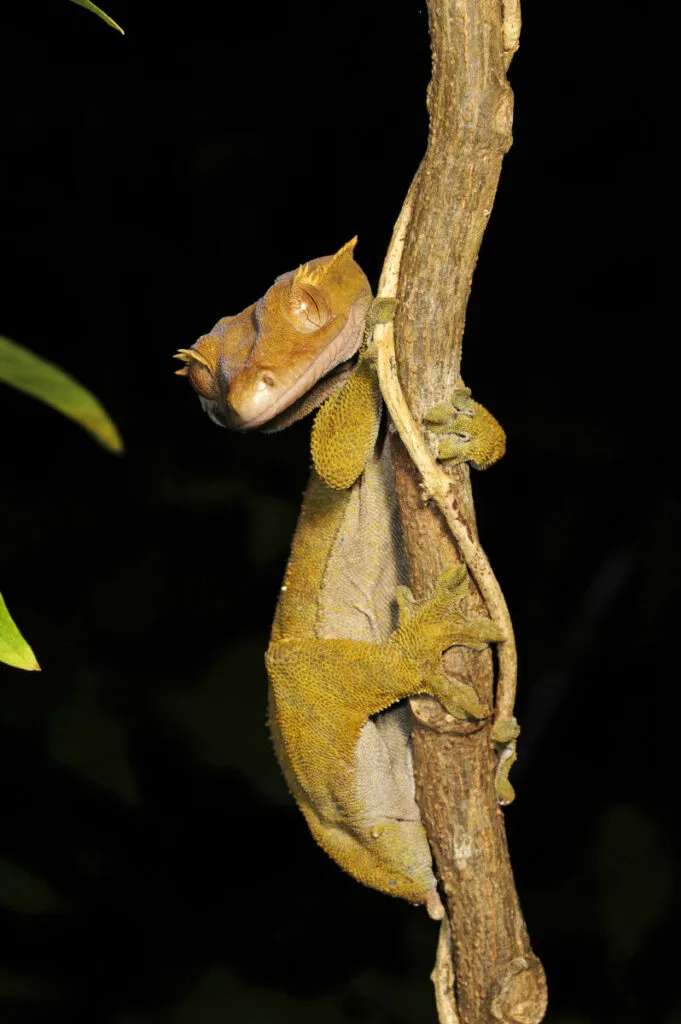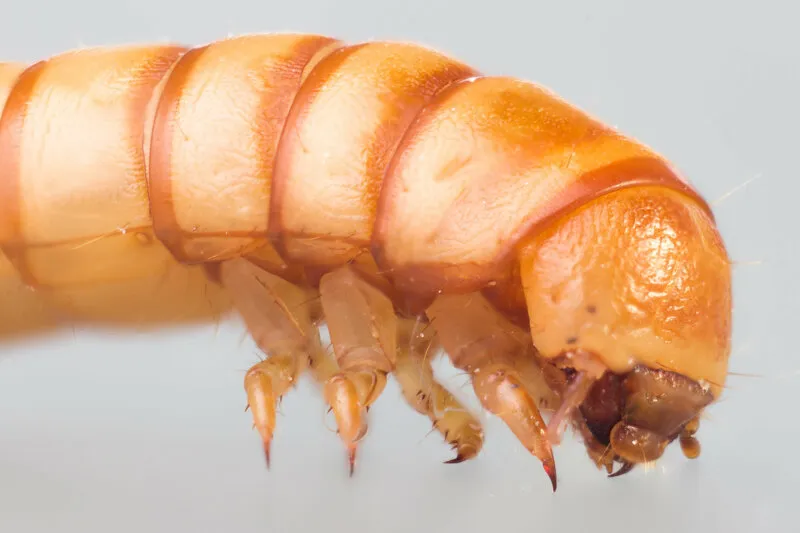
Crested gecko owners sometimes feed mealworms to their beloved pets because they are an easy option. Even some pet shop owners recommend mealworms as a great
Crested geckos should only eat mealworms occasionally. Mealworms are difficult to digest, causing constipation and impaction. They can also cause overweight and health issues in crested geckos such as metabolic bone disease due to high levels of fat and poor calcium to phosphorus ratios.
If mealworms are so bad for crested geckos, then why do they seem such a popular option for pet owners? The answer might surprise you. Read on to find out more about mealworms, alternative feeder insects, and when it is okay to feed mealworms to your crested gecko.
Table of Contents
Why Mealworms Are Bad for Crested Geckos
Despite their common use as treats, there is a long list of reasons why you should think twice about giving them to your gecko buddy.
High in Fat
There are several different types of mealworm and they all contain different amounts of fat. Most mealworms contain far higher amounts of stored fat than other insects (we’ll look at the exact nutrition later). A rough estimate is that most mealworms contain between 15% and 25% fat.
Why is this a problem?
Well, fats are good in moderation, but too much of them cause significant health problems (I know this personally as cheesecake is the devil). This is also true for crested geckos.
A high-fat diet for your gecko can result in:
- Fat folds where the skin wrinkles
- Lethargy
- Cardiovascular diseases
- Malnutrition through diet imbalance
- Strain on other organs
Research into reptile cardiology is in its infancy, but researchers have discovered mineralization of blood vessels due to nutritional deficiencies.
Because heart disease in humans and heart valve issues in other animals have been directly linked to fat consumption, it’s more than likely that crested geckos and other lizards will suffer similar illnesses.
This all amounts to one thing: The high-fat content of mealworms could shorten the lifespan of your crested gecko.

Difficult to Digest
Mealworms have four stages of development: Egg, Larva, Pupa, and Adult. When fully adult, they become a beetle known as the mealworm beetle or Tenebrio Molitor if you want to shock someone with your mealworm trivia skills at a party.
It’s the larval stage when mealworms are harvested and fed to crested geckos. This stage causes specific problems and, in some instances, can lead to serious health issues for your pet.
Larva mealworms have a tough exoskeleton that covers the body. It’s made from a substance called chitin, which is the same material that makes fish scales.
Needless to say, this stuff is very difficult to digest, but your crested gecko doesn’t know to open up the worm and just eat the good stuff inside. It swallows the whole thing!
In some cases, the chitin exoskeleton gets stuck inside the digestive tract. This causes impaction, which is a blockage. It can be life-threatening. Reducing the number of mealworms in your gecko’s diet can lower this risk.
Hunting Stimulation
In the wild, crested geckos switch between being omnivorous and frugivorous. This means that they eat either a varied diet of fruits, roots, and insects, or they sometimes they rely almost entirely on fruit.
Despite this latter point, their omnivorous traits mean that they do occasionally hunt. Their hunting behavior often involves climbing through the canopy of trees and other plants looking for insects.
If they do turn to eating mostly insects, it’s probably due to their high protein content and occasions when plant
A mixture of fruit and nutritional insects is therefore the best type of diet for a crested gecko.
When mealworms are almost exclusively given to crested geckos, this causes two problems:
- Ignoring vitamin and other nutrient requirements that crested geckos need from fruit and other plant sources.
- Undermining the animals instinctive need to hunt.
A healthy crested gecko diet needs to include a supplement of feeder insects to mimic their natural diet in the wild.
Mealworms are not the type of insect a crested gecko will normally eat in their natural environment.
While mealworms can move around, they are slow and methodical. This means that, as prey, they are not very stimulating for crested geckos because they cannot try out their hunting impulses.
This can lead to stress, like an itch you can’t scratch! Hunting will also keep your crested gecko fit and agile, rather than lazy and sedentary.

Food Habituation
Animals quickly learn about their environments. One of the main things they pick up on is what is
This is an evolutionary strength that helps animals to seek out
Over time, your leopard gecko will become addicted to the high-fat content of the mealworms and will shun other
This happens when mealworms are given too often. In the wild,
We’ll explore this later, but you want to provide healthy feeder insects and fruit for your crested gecko, changing things up regularly so that they keep an interest in different types of
Other Issues with Meal Worms
Giving mealworms to your crested gecko, especially regularly, can cause some other, secondary issues.
These aren’t quite as common, so I’ve kept them separate from the main issues, but you should still be aware of them when making decisions about whether to feed mealworms to your crested gecko or not.
Escape Artists
As a larval beetle, the Tenebrio Molitor mealworm has a trick up its sleeve to avoid predators until it’s in its more mobile adult form.
Mealworms can burrow into the ground.
If your crested gecko doesn’t eat every mealworm, you might end up with some burrowing worms in your
However, most of the healthy, ideal substrates for crested geckos consist of things like sphagnum moss, coconut bedding, organic soil mix, or cypress mulch. A mealworm can easily burrow into all of these materials.
Once under the substrate, a mealworm, if fed enough, will turn into a pupa (it kind of looks like something out of Alien!). The pupa will eventually hatch into a beetle, which will now scurry around the
Crested geckos are unlikely to eat these beetles because their exoskeleton is so tough, and if they did, it could cause digestive problems.
The burrowing and hatching behavior of the mealworm can result in damaged, more loose substrate and the production of smaller pieces of substrate that could be swallowed by your pet.
This is why mealworms should be offered sparingly so that you don’t end up with an army of beetles climbing around your

Mealworms and Health Issues
Mealworms are so often fed to pets (and even consumed by humans in some places) that we forget the health problems they can cause. When in their larval stage, mealworms can carry:
- Salmonella
- E Coli
- Staph
- Avian Flu
In fairness, these illnesses are usually only found when the worms are kept in and around birds, but these diseases have been known to transmit to humans.
When the worms go through their pupa and then adult stages, their beetle form can also cause problems for your crested gecko.
Fully grown adult mealworm beetles produce a poison known as benzoquinone. While this poison won’t kill you or your gecko immediately, benzoquinone is known to be carcinogenic – cancer-causing (yes, lizards can get cancer).
Just another reason to stop them from burrowing!
Mealworms Can Bite
Mealworms have three major parts to their anatomy:
- The Head
- Thorax
- Abdomen
The abdomen constitutes most of a mealworm’s body, with the thorax being a third the size of the abdomen, but it’s the head that can cause your crested gecko serious problems.
The head contains several parts that cause issues together. The mouth with its powerful jaws, the labrum, which sits above the mouth and aids eating, and two claws that are used to hang onto
The combination of these three parts gives the mealworm a powerful bite.
While a crested gecko is far more powerful than a single mealworm, it can still cause a wound if it bites. If mealworms escape the clutches of a gecko, they can bite at its legs (another reason to feed them sparingly and not let them wander around your
Mealworms can also bite as they are being eaten. This can result in bites to the face or mouth of your gecko. These wounds can even put your gecko off from feeding for a while.
These bites are rare, but they do happen, and so it’s worth knowing about.
What About Mealworms Eating Through the Stomach?
One thing to note: There is a mealworm urban legend. It states that mealworms can survive being eaten and the heads can chew up the insides of a lizard. As far as I’m aware, this has never been proven.
Most of the time, these stories actually come from supposed incidents involving Zophobas Morio, also known as a superworm.
This is a different species from the common mealworm. It becomes a beetle, like a mealworm, looks similar, but grows to four times the size!
Even these mighty creatures would probably have too much trouble eating the insides of an animal.
Here’s a great report on experiments testing whether superworms are indeed capable of this behavior. Basically, it says that superworms can’t eat through an animal’s stomach. As soon as they are in the stomach, they remain still, even if they are still alive.

Mealworms Vs Other Feeder Insects
There are two things you should think of when choosing a
- Is this
food source good for my pet? - Are there better
food sources available?
As I’ve said, occasional feeding of mealworms is okay, but you wouldn’t want to make them a staple. They should be a supplement. If you look at other types of feeder insects in comparison to mealworms, you can see why others should be used as a primary
Before you look at the table below, keep in mind that you want a crested gecko’s
The more phosphorus in a
Feeder Insect and Grub Nutritional Values
| Insect or Worm | Protein | Fat | Fibre | Moisture | Calcium to Phosphorus ratio | Ash |
| Banana Roaches | Unknown | Unknown | Unknown | Unknown | Unknown | Unknown |
| Butterworms | 16% | 17% | 1% | 60% | 1:18 | 1% |
| Calcium Worms | 17% | 11% | 6% | 64% | 3:1 | 5% |
| Crickets | 18% | 6% | 2% | 73% | 1:9 | 2% |
| Death’s head Roaches | 11% | Unknown | Unknown | 79% | Unknown | 0% |
| Discoid Roaches | 20% | 7% | 3% | 66% | 1:3 | 0% |
| Dubia Roaches | 21% | 9% | 5% | 65% | 1.5:1 | 1% |
| Earthworms | 21% | 5% | 5% | 82% | 1:10 | 2% |
| Fruit Flies | 21% | 5% | 5% | 70% | Unknown | 2% |
| Grasshoppers | 20% | 2% | 5% | 72% | Around 1:5 | 2% |
| Hornworms | 9% | 3% | 1% | 85% | 1:3 | 1% |
| Locusts | 22% | 9% | 4% | 62% | 1:6 | 3% |
| Mealworms | 19% | 9% | 2% | 65% | 1:7 | 2% |
| Nightcrawlers | 10% | 2% | 2% | 84% | 1.5:1 | 2% |
| Red Runner Roaches | 17% | 5% | 2% | 74% | 1:3 | 2% |
| Silkworms | 13% | 2% | 3% | 79% | 1:2.4 | 1% |
| Silkworm Pupae | 15% | 6% | 2% | 76% | Unknown | 1% |
| Snails (No shell) | 19% | 1% | 3% | 76% | Unknown | 2% |
| Superworms | 19% | 16% | 4% | 60% | 1:18 | 1% |
| Waxworms | 14% | 18% | 3% | 62% | 1:7 | 1% |
If we look at the above table, we can see that some insects and larvae have lower fat and better calcium to phosphorus ratios. These are the types of insects you should prioritize over mealworms.
Good options include:
- Earthworms
- Roaches
- Crickets
- Calcium worms
Fruit Alongside Feeder Insects and Larvae?
I mentioned earlier that crested geckos can sometimes veer towards a fruit-based diet. In the wild, they will eat a lot of fruit, and so you should stay away from making their diet entirely meat-based.
A varied diet of fruit and feeder insects will keep your crested gecko safe from malnutrition.
Offer some of these to your crested gecko, regularly:
- Blueberry
- Peach
- Mango
- Pear
- Banana
- Fig
- Grape
- Apricot
- Strawberry
- Watermelon
- Dates
- Peach
- Plum
This can be mashed up and left in a feeding bowl, especially if it’s elevated or on a ledge, as crested geckos often eat fruit from the branches of trees.
What About Dried Mealworms?
It can be tempting to feed your crested gecko dried mealworms, as they are easier to deal with, but they do lead to other problems.
Dried mealworms don’t have the same nutritional value as live mealworms. Considering that live mealworms are already nutritionally lacking, the drying process only makes this worse.
This can be offset slightly by dusting them with calcium and vitamin D. However, they still should only be given as a treat due to their high-fat content.
Dried mealworms don’t move (unless they’re zombies, but my research suggests this is doubtful). By offering dead larvae or insects to your crested gecko, you’re encouraging it to abandon its hunting behavior.
Basically, dried mealworms are boring for your pet!
Conclusion
I hope you’ve found this article helpful when thinking about mealworms as a food source for your crested gecko. I’d love to hear your thoughts on whether you think mealworms are a good idea for crested geckos, so please do let me know your experiences in the comments below.
- Enchi Ball Python: A Unique and Stunning Morph of Python regius - March 27, 2025
- Emerald Tree Monitor: The Enigmatic Green Guardian of the Rainforest - March 26, 2025
- The Egyptian Cobra (Naja haje): A Fascinating Serpent - March 25, 2025
